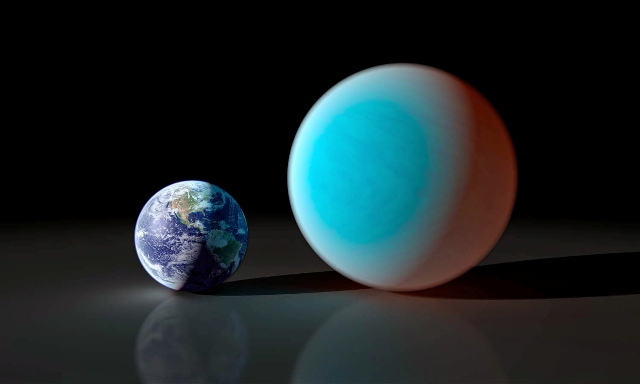Dec 2 2014
Astronomers have measured the passing of a super-Earth in front of a bright, nearby Sun-like star using a ground-based telescope for the first time. The transit of the exoplanet 55 Cancri e is the shallowest detected from the ground yet. Since detecting a transit is the first step in analyzing a planet's atmosphere, this success bodes well for characterizing the many small planets that upcoming space missions are expected to discover in the next few years.
 This artist's conception shows the super-Earth 55 Cancri e (right) compared to the Earth (left). Astronomers using a ground-based telescope have measure the transit of 55 Cancri e for the first time. It is the shallowest transit ever detected from the ground. (NASA/JPL)
This artist's conception shows the super-Earth 55 Cancri e (right) compared to the Earth (left). Astronomers using a ground-based telescope have measure the transit of 55 Cancri e for the first time. It is the shallowest transit ever detected from the ground. (NASA/JPL)
The international research team used the 2.5-meter Nordic Optical Telescope on the island of La Palma, Spain, a moderate-sized facility by today's standards but equipped with state-of-the-art instruments, to make the detection. Previous observations of this planet transit had to rely on space-borne telescopes.
The host star, 55 Cancri, is located just 40 light-years away from us and is visible to the naked eye. During its transit, the planet crosses 55 Cancri and blocks a tiny fraction of the starlight, dimming the star by 1/2000th (or 0.05%) for almost two hours. This shows that the planet is about twice the size of Earth, or 16,000 miles in diameter.
"Our observations show that we can detect the transits of small planets around Sun-like stars using ground-based telescopes," says Ernst de Mooij of Queen's University Belfast in the United Kingdom, lead author of the study.
He continues, "This is especially important because upcoming space missions such as TESS and PLATO should find many small planets around bright stars and we will want to follow up the discoveries with ground-based instruments."
TESS is a NASA mission scheduled for launch in 2017, while PLATO is to be launched in 2024 by the European Space Agency; both will search for transiting terrestrial planets around nearby bright stars.
"With this result we are also closing in on the detection of the atmospheres of small planets with ground-based telescopes," says co-author Mercedes Lopez-Morales of the Harvard-Smithsonian Center for Astrophysics (CfA). "We are slowly paving the way toward the detection of bio-signatures in Earth-like planets around nearby stars."
"It's remarkable what we can do by pushing the limits of existing telescopes and instruments, despite the complications posed by the Earth's own turbulent atmosphere," says study co-author Ray Jayawardhana of York Univerity in Canada. "Remote sensing across tens of light-years isn't easy, but it can be done with the right technique and a bit of ingenuity."
The planet 55 Cancri e is about twice as big and eight times as massive as Earth. With a period of 18 hours, it is the innermost of five planets in the system. Because of its proximity to the host star, the planet's dayside temperature reaches over 3100° Fahrenheit (1700° Celsius), hot enough to melt metal, with conditions far from hospitable to life. Initially identified a decade ago through radial velocity measurements, it was later confirmed through transit observations with the MOST and Spitzer space telescopes.
Until now, the transits of only one other super-Earth, GJ 1214b circling a red dwarf, had been observed with ground-based telescopes. The Earth's roiling air makes such observations extremely difficult. But the team's success with 55 Cancri e raises the prospects of characterizing dozens of super-Earths likely to be revealed by upcoming surveys.
"We expect these surveys to find so many nearby, terrestrial worlds that space telescopes simply won't be able to follow up on all of them. Future ground-based instrumentation will be key, and this study shows it can be done," adds Lopez-Morales.
The research team also includes Raine Karjalainen and Marie Hrudkova of the Isaac Newton Group of Telescopes. Their findings appear in a paper to be published in The Astrophysical Journal Letters.
Headquartered in Cambridge, Mass., the Harvard-Smithsonian Center for Astrophysics (CfA) is a joint collaboration between the Smithsonian Astrophysical Observatory and the Harvard College Observatory. CfA scientists, organized into six research divisions, study the origin, evolution and ultimate fate of the universe.